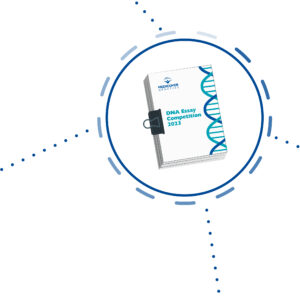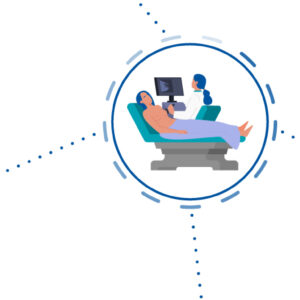Scientific Background
Osteogenesis imperfecta (OI) or brittle bone disease (frequency about 1:10,000) is a clinically and genetically heterogeneous group of diseases characterized by increased bone fragility, which apart from very rare forms, are inherited in an autosomal dominant manner. In 97% of OI type I cases and 77% of moderate to severe forms, causative variants can be detected in the COL1A1 and COL1A2 genes, which often lead to the substitution of glycine in the triple helix domain of type I collagen. In about 9% of moderate to severe cases, variants in the IFITM5 gene are the cause. The clinical symptoms depend on the affected gene and the type and localization of the variant (genotype-phenotype correlation). The rare autosomal recessive inherited forms of OI are mostly characterized by specific clinical features. International guidelines currently recommend these genes are only analyzed after thorough clinical evaluation.
Autosomal dominant inherited forms (frequent)
Type I (most frequent form accounting for about 65% of cases) is characterized by a mild course with a moderate number of bone fractures (10-20 bone fractures before puberty), blue discoloration of the sclera, and postpubertal hearing loss in 50% of those affected. Tinnitus, aortic insufficiency and thin skin (in about 20% of cases) are also characteristic. A distinction is made between type IA and type IB, which occur with and without dentinogenesis imperfecta, respectively.
Type II (approximately 20% of cases) is the most severe form of the disease and is usually lethal intrauterine in the first weeks of life. Sporadic cases are often caused by germline mosaics, and the risk of recurrence in subsequent pregnancies is about 10%.
Type III (about 5% of cases) is phenotypically particularly variable. Extremely short stature, skeletal deformities, about 100 bone fractures up to puberty and hearing loss are typical. Soft bones, scoliosis and dentinogenesis imperfecta are also characteristic.
Type IV (approximately 10% of cases) is a mild form with small stature and moderate skeletal deformities, without scleral discoloration and with moderate bone fragility. A distinction is made between subtype A and B, which occur with and without dentinogenesis imperfecta, respectively.
The disease is caused by variants in the type I collagen genes COL1A1 (two thirds of cases) and COL1A2 (one third of cases), which lead to the reduced synthesis of procollagen alpha1 or alpha2, or to a structural change in the collagen. The phenotypic heterogeneity is probably caused by the influence of modifying genes and by structural differences. A total of about 1,000 variants have been described, of which about 60% concern the amino acid glycine.
Type V has been described in a few individual cases with hypertrophic callus formation, mesh-like bone histology, dense epiphyses, skeletal deformities and variable bone fragility of unknown cause.
References
Zhytnik et al. 2019, Mol Genet Genomic Med 7:e559 / Caparros-Martin et al. 2017, Mol Genet Genomic Med 5:28 / Bardai et al. 2016, Osteoporosis Int 27:3607 / Forlino et al. 2016, Lancet 387:1657 / Valadares et al. 2014, J Pediatr 90:536 / Caparros-Martin et al. 2013, Am J Med Genet 161:1354 / van Dijk et al. 2012, EJHG 20:11 / Forlino et al. 2011, Nat Rev Endocrinol 7:540 / Alanay et al. 2010, Am J Hum Genet 86:551 / Barnes et al. 2010, NEJM 362:521 / Willaert et al. 2009, J Med Genet 46:233 / Baldridge et al. 2008, Hum Mutat 29:1435 / Marini et al. 2007, Hum Mutat 28:209





















